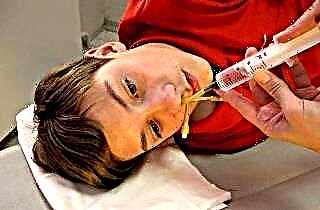What we call "Father George's Tea" is a variant of "Monastic Tea", which appeared as a way to effectively and long-term relief from diseases of the throat, nose and other otolaryngological problems. The composition contains the same components as in the original recipe, however, their quantitative ratio is different, which gives an increase in some and a decrease in other therapeutic manifestations. But it is not known which of the two versions of the famous tea is considered the original and the best.
Dispute of monasteries: where was the recipe for the remedy created?
 They say a lot about "Monastic tea". In short, the recipe of 16 natural ingredients "went to the people" after it was compiled by the abbot of the Holy Spirit Monastery Schema-Archimandrite George. The abbot in his monastery was actively involved in healing not only spiritual, but also bodily ailments, devoted a lot of time to this, and all the same - the flow of those wishing to get to him for an appointment did not diminish until the death of George in 2011.
They say a lot about "Monastic tea". In short, the recipe of 16 natural ingredients "went to the people" after it was compiled by the abbot of the Holy Spirit Monastery Schema-Archimandrite George. The abbot in his monastery was actively involved in healing not only spiritual, but also bodily ailments, devoted a lot of time to this, and all the same - the flow of those wishing to get to him for an appointment did not diminish until the death of George in 2011.
Most of the recipes for healing infusions, of course, were prescribed individually - George was an experienced herbalist and could collect the most effective herbal composition in 10 minutes. But "The Gathering of Father George" became an exception in this sense. His father George was specially compiled so that each person could effectively fight the most common ailments, without waiting for reception in many months of queues. In this case, various diseases of the nasopharynx became such "common ailments". Strengthening immunity with the help of the monastery collection during one standard or extended course (1-3 months) gave a person a "margin of safety" for the whole year and relieved most viral and bacterial infections with high efficiency.
In general, this would have been enough to strengthen the high reputation of the monastery tea, but a serious battle broke out between the "fans" of Father George's herbal collection over the question of where exactly George learned his famous recipe.
- Some argued that the recipe was restored by George from the lost ancient manuscripts that existed in some "northern monasteries of Russia" several hundred years ago. This version should be recognized as the least probable and untenable, if only because the question immediately arises: how to revive an old recipe if no information has been preserved about it?
- Others talked about the "Athonite trail" of the drug. That is, in this version, it was said that George received the recipe for tea from the Athonite monks during his stay in a Greek monastery. This assumption is most likely true, but:
- firstly, it refers to the classic recipe of "Monastic tea" and to those proportions of medicinal herbs that were used in their medicinal composition by the Athonite monks.
- secondly, it seems that it was George who brought to Athos the knowledge about the later popular natural gathering.
Where did you bring it from?
- The third version is the most interesting and it leads to a monastery on the border with Romania, in which the future abbot stayed for several years as a novice., and where he first showed interest in the art of healing with the gifts of nature. It is believed that it was there that George first learned about 16 components, which, in combination with each other, gave the effect of synergy - an increase in the healing effect. Moreover, that original composition differed from the Greek one not so much in the selection of components as in their proportional content in the collection and in the technique of processing plants.
The last version is also supported by the legend that has survived to this day in the Southern Carpathians about a girl who turned into a bird, who, from new moon to full moon, had to find one plant for the magic elixir every day (for 16 days). If in some of the 16 days she had not found the coveted component, the spell would not have been broken and the heroine of the legend would have remained a bird forever. But the enchanted girl managed to cope with the task and, having drunk the compiled elixir, she again became a man, without losing the ability to talk with birds and animals in the same language.
The version of the legend that has come down to us even mentions some of those natural components that can be found today in the collection of Father George: thyme, rose hips, sage, buckthorn, succession (however, in the legend they appear under local Romanian names).
Thus, one can almost certainly say that Father George learned his famous recipe in his youth, later composing on its basis the classic "Monastery tea".
Find out the price
The composition of "tea, or What is the main thing in the" Monastic collection "?
 To single out one main ingredient from a composition, which is valuable precisely for its integrity, means to destroy the very idea of collection, where each of the elements in a given proportion complements the action of the others. For this, compositions are created so that the action of all the components put together is larger and more powerful than a simple sum of terms. Dividing a natural complex into elements is like separating individual instruments from a well-coordinated symphony orchestra and trying to understand how the whole orchestra will play by their sound. But even with a cursory listing of the properties of some components, you can understand the collection capabilities in general.
To single out one main ingredient from a composition, which is valuable precisely for its integrity, means to destroy the very idea of collection, where each of the elements in a given proportion complements the action of the others. For this, compositions are created so that the action of all the components put together is larger and more powerful than a simple sum of terms. Dividing a natural complex into elements is like separating individual instruments from a well-coordinated symphony orchestra and trying to understand how the whole orchestra will play by their sound. But even with a cursory listing of the properties of some components, you can understand the collection capabilities in general.
- Nettle - cleanses the circulatory system from toxins and at the same time stimulates metabolism.
- Immortelle - lowers the level of cholesterol in blood vessels, activates the choleretic effect.
- Sage - fights against the activity of bacteria, helps to improve the functioning of the gastrointestinal tract.
- Rosehip - as a source of a unique combination of vitamins, microelements, flavonoids, malic and citric acids is present in almost all natural preparations.
- Thyme is famous for its pronounced antiseptic properties and the ability to suppress the development of tumors.
- Bearberry - due to its high content of antioxidants, it slows down the aging process.
The right way to brew
 One of the reasons for the popularity of the herbal collection is its ease of preparation. In general, the brewing of the collection resembles the procedure for brewing ordinary tea, only the herbal crumbs filled with boiling water must be allowed to brew for half an hour.
One of the reasons for the popularity of the herbal collection is its ease of preparation. In general, the brewing of the collection resembles the procedure for brewing ordinary tea, only the herbal crumbs filled with boiling water must be allowed to brew for half an hour.
Servings for consumption are also tea-sized - 100-150 milliliters. Like any product with a concentrated content of active substances, it cannot be used uncontrollably, therefore the maximum duration of the course is limited to three months. The standard course for normalizing the state of the nasopharynx and preventing colds lasts 1 month.
Expert opinions and consumer reviews
Here, as very indicative, I would like to publish an excerpt of spontaneously arisen correspondence from one political forum, which had nothing to do with health issues, but at which the topic of "Monastic tea" by Father George was accidentally touched upon:
Mirta from the city of Nizhny Novgorod writes:
“@ Karolina1111, I still don’t understand from your reasons why you should buy this fee for money (albeit not big, but still for money). Take the herbal guide in one hand, the basket in the other hand, and walk around the neighborhoods of your city for yourself. I assure you that you collect no less useful plants, from which you can then prepare any infusion for yourself. So it will be both free and reliable. You will know exactly what you ripped off and where. Moreover, the walk in the fields itself will additionally improve your health.».
@ Karolina1111 from Saint Petersburg writes:
«Mirta, thanks for the advice, but if you don't understand, I answer point by point.Taking the “herbal reference book” in one hand is already a problem for those who do not have one, and who know absolutely nothing about the selection of herbs or the way of storing them. In order to comprehend this science, I have to put aside my main work and start studying "from scratch" a completely new and unfamiliar area of knowledge. This means that I will not earn where I could earn normal money in order to save, as you yourself said, an insignificant amount.
In addition, I suspect that in the vicinity of my city, located on the 69th parallel, neither wormwood, nor motherwort, nor cat's paw grows. Buying these plants on the Internet separately from each other again poses daunting tasks to me for the experimenter, who must guess the proportions and repeat the already proven and working recipe. Explain to me, please, why should I reinvent the wheel if you can buy it ready-made and for a penny?»
The question of "reinventing the wheel" is becoming a cornerstone for some doctors as well.
Kuchinsky M.N. ENT (otolaryngologist, Moscow):
«On the one hand, we are faced here with classical folk remedies, which, although they confirm their effectiveness, are outside of medicine. On the other hand, as a doctor, I do not understand why I should artificially seek a drug replacement for the "Monastery collection", if now - I have in my hands an effective and safe drug, which I myself have tested on myself. Antibiotics will come in handy later if the person does get sick. But you don't need to eat cutlets with them after every dinner. It is much better to take preventive measures - to drink the same "Monastery tea" so that antibiotics do not come down to it at all».
Go to the official website



